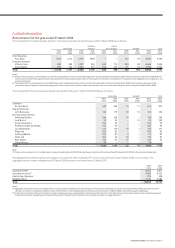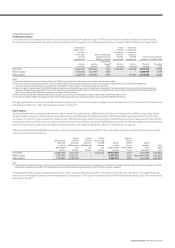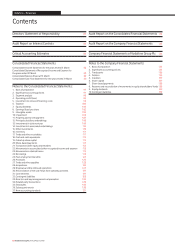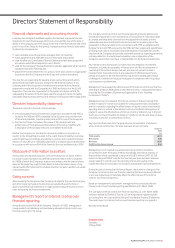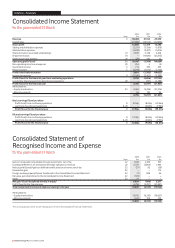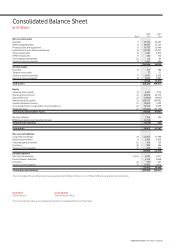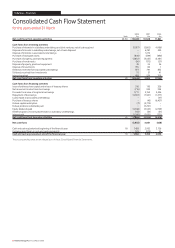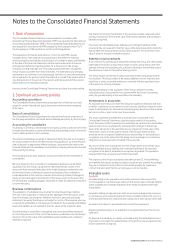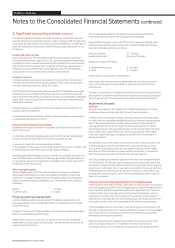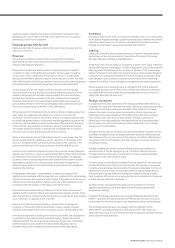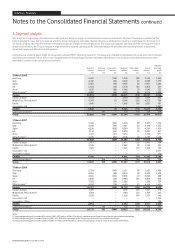Vodafone 2008 Annual Report Download - page 89
Download and view the complete annual report
Please find page 89 of the 2008 Vodafone annual report below. You can navigate through the pages in the report by either clicking on the pages listed below, or by using the keyword search tool below to find specific information within the annual report.
Arrangements with multiple deliverables
In revenue arrangements including more than one deliverable, the arrangement
consideration is allocated to each deliverable based on the fair value of the
individual element. The Group generally determines the fair value of individual
elements based on prices at which the deliverable is regularly sold on a
standalone basis, after considering volume discounts where appropriate.
Deferral period
Customer connection fees, when combined with related equipment revenue,
in excess of the fair value of the equipment are deferred and recognised over the
expected life of the customer relationship. The life is determined by reference
to historical customer churn rates. An increase in churn rates would reduce the
expected customer relationship life and accelerate revenue recognition.
Historically, changes to the expected customer relationship lives have not had
a significant impact on the Group’s results and financial position.
Any excess upgrade or tariff migration fees over the fair value of equipment
provided are deferred over the average upgrade or tariff migration period
as appropriate. This time period is calculated based on historical activity of
customers who upgrade or change tariffs. An increase in the time period would
extend the period over which revenue is recognised.
Presentation
When deciding the most appropriate basis for presenting revenue or costs of
revenue, both the legal form and substance of the agreement between the Group
and its business partners are reviewed to determine each party’s respective role in
the transaction.
Where the Group’s role in a transaction is that of principal, revenue is recognised
on a gross basis. This requires revenue to comprise the gross value of the
transaction billed to the customer, after trade discounts, with any related
expenditure charged as an operating cost.
Where the Group’s role in a transaction is that of an agent, revenue is recognised
on a net basis, with revenue representing the margin earned.
Taxation
The Group’s tax charge on ordinary activities is the sum of the total current and
deferred tax charges. The calculation of the Group’s total tax charge necessarily
involves a degree of estimation and judgement in respect of certain items whose
tax treatment cannot be finally determined until resolution has been reached with
the relevant tax authority or, as appropriate, through a formal legal process. The final
resolution of some of these items may give rise to material profit and loss and/or
cash flow variances. See “Financial Position and Resources” on page 54.
The complexity of the Group’s structure following its geographic expansion makes
the degree of estimation and judgement more challenging. The resolution of
issues is not always within the control of the Group and it is often dependent
on the efficiency of the legal processes in the relevant taxing jurisdictions in
which the Group operates. Issues can, and often do, take many years to resolve.
Payments in respect of tax liabilities for an accounting period result from payments
on account and on the final resolution of open items. As a result, there can be
substantial differences between the tax charge in the Consolidated Income
Statement and tax payments.
Significant items on which the Group has exercised accounting judgement include
a provision in respect of an enquiry from UK HMRC with regard to the CFC tax
legislation (see note 32 to the Consolidated Financial Statements), potential tax
losses in respect of a write down in the value of investments in Germany (see note
6 to the Consolidated Financial Statements) and litigation with the Indian tax
authorities in relation to the acquisition of Vodafone Essar (see note 32 to the
Consolidated Financial Statements). The amounts recognised in the Consolidated
Financial Statements in respect of each matter are derived from the Group’s best
estimation and judgement, as described above. However, the inherent uncertainty
regarding the outcome of these items means eventual resolution could differ from
the accounting estimates and therefore impact the Group’s results and cash flows.
Recognition of deferred tax assets
The recognition of deferred tax assets is based upon whether it is more likely
than not that sufficient and suitable taxable profits will be available in the future,
against which the reversal of temporary differences can be deducted.
Recognition, therefore, involves judgement regarding the future financial
performance of the particular legal entity or tax group in which the deferred
tax asset has been recognised.
Historical differences between forecast and actual taxable profits have not
resulted in material adjustments to the recognition of deferred tax assets.
Revenue recognition and presentation
Revenue from mobile telecommunications comprises amounts charged to
customers in respect of monthly access charges, airtime charges, messaging,
the provision of other mobile telecommunications services, including data services
and information provision, fees for connecting users of other fixed line and mobile
networks to the Group’s network, revenue from the sale of equipment, including
handsets, and revenue arising from the Group’s partner network agreements.
Vodafone Group Plc Annual Report 2008 87


